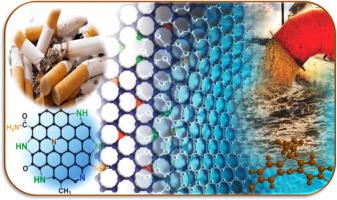Journal of King Saud University-Science ( IF 3.8 ) Pub Date : 2020-09-25 , DOI: 10.1016/j.jksus.2020.09.021 Norah S. Alhokbany , Mu Naushad , Vikrant Kumar , Saad Al hatim , Saad M. Alshehri , Tansir Ahamad

|
The fabrication of highly porous functionalized carbon materials is the demand of current scenario for the removal of toxic pollutants form aqueous solution. Therefore, waste cigarette butts that consist of cellulose acetate and other nitrogen rich compounds, such as nicotine and harmine have been used for the fabrication of N-doped carbon aerogel (NDC) via hydrothermal and carbonization process. As-fabricated NDC was characterized via, elemental analysis, FTIR, Raman, TGA, XRD, BET, SEM and XPS and used for the adsorption of bisphenol –A (BPA). The outcomes of adsorption essay and its kinetics support that the adsorption of BPA over NDC was carried out via pseudo-second-order kinetic model and via Langmuir model isotherm. The values for ΔG and ΔH were found negative and positive respectively, and support that the adsorption process is spontaneous and endothermic. The nature of adsorbent as well as in-situ and post characterization of the adsorbent support the adsorption mechanism, and the conclusions support that the hydrogen bonding, electrostatic as well as the π-π interactions were employed between the BPA and NDC during adsorption. In addition, the regeneration of the NDC was efficiently achieved and BPA removal efficiency remained high (92.47%) after seven cycles.
中文翻译:

源自废烟头(醋酸纤维素)的自氮掺杂碳气凝胶用于吸附BPA:动力学和吸附机理
目前,从水溶液中去除有毒污染物的需求是制造高度多孔的功能化碳材料。因此,由醋酸纤维素和其他富氮化合物(例如尼古丁和丁香)组成的废烟头已被用于通过水热和碳化工艺制造掺氮碳气凝胶(NDC)。通过元素分析,FTIR,拉曼,TGA,XRD,BET,SEM和XPS对制成的NDC进行表征,并用于吸附双酚-A(BPA)。吸附论文的结果及其动力学支持了BPA在NDC上的吸附是通过拟二级动力学模型和Langmuir模型等温线进行的。发现ΔG和ΔH分别为负值和正值,并支持吸附过程是自发的且吸热的。吸附剂的性质以及吸附剂的原位和后表征都支持吸附机理,结论表明,在吸附过程中,BPA和NDC之间采用了氢键,静电以及π-π相互作用。另外,有效地实现了NDC的再生,并且在七个循环之后,BPA去除效率仍然很高(92.47%)。


























 京公网安备 11010802027423号
京公网安备 11010802027423号